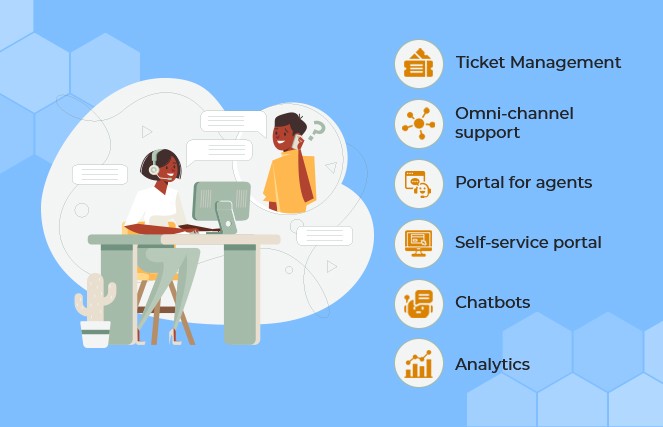IT service desks are one of the major drivers of customer experience. Service desks are an entry point of contact for all users, where service providers receive the demand for incident resolution and service requests.
Nowadays, self-service portals and chatbots are at the peak choices in handling user issues. IT service desks are a primary point of engagement between users and service providers for day-to-day activities. This includes managing service disruptions, service requests, handling user communications, and planning workflows and services. IT service desks also involve human touch, especially at the complex places where empathy is much needed.
In a broader scope, the service desk is designed to provide users with a single point of contact for their IT needs. The service desks play a pivotal role in integrating the business processes with the technology ecosystem. So, if you’re looking forward to starting or upgrading your service desk support, you’ve come to the right place. In this article, we will discuss:
- How do IT Service Desks Work?
- What is the Role of the Service Desk in an Organization?
- Some Popular Service Desk Metrics
- Key Advantages of the Service Desk
- The Best Way to Operate Service Desk
- How You Can Upgrade Your Service Desk with DeskXpand
Let us begin!
What is an IT Service Desk?
IT service desk is more like a ticket management system that allows enterprises to implement robust and effective workflows for customer support departments. It enables the admin and the helpdesk staff to keep track of queries raised by users. It also includes reassigning these queries to the relevant department, generating reports, metrics, and more.
How Do IT Service Desks Work?
Service desks play a major role in ensuring the availability of deliverable services. A well-implemented service desk drives efficiency throughout the organization. However, a poorly executed service desk may weigh down your business.
Service desks help you handle everything from essential activities to complex ones. Starting with agent support, service desks help companies handle the project timeline, resources, incoming tickets, ticket categories, staff, response time, workflows, and so on. Furthermore, admins can define service level agreements, confirm ticket due dates, set warnings, send notifications, and so on.
Admins can also set auto-responders, add knowledge base articles, automatically assign tickets based on the agent expertise, and so on.
What is the Role of the Service Desk in an Organization?
Some popular service desk roles involve serving as a point of contact for all issues pertaining to an organization. Service desks are responsible for effectively managing customer expectations.
Service desk roles also involve setting an organizational standard for customer engagement, serving as a communication channel between customers and the organization. Service desks provide the first-contact resolution for customers. Other service desk roles and responsibilities include:
- Identifying and pursuing service improvement initiatives in an organization. Analyze and improve the overall team performance.
- Managing complaints and suggestions. Making sure that the customer reaches you and their queries don’t slip through the crack. Making sure that the tickets are registered from all the channels seamlessly.
- Understanding and responding to customer satisfaction metrics. Assigning the queries to a relevant team or agent. Training service desk analysts on how to deliver services for customers.
- Sending auto-responders or canned (but personalized) messages to keep customers involved at every stage of the journey.
- A service desk manager’s role includes request fulfillment support. They need to ensure that the tools, processes, etc., are maintained adequately.
- Include and enable automated self-service options that proactively reduce service requests and help maintain agreed service levels.
- Service desk roles also involve logging and categorizing service requests based on their type and priority.
- It also includes verifying customers who are submitting the service requests through their customer history. Managing and storing this data for further communication is also a must.
- Service desk roles also involve request model execution. It simply means fulfilling requests in an appropriate time frame.
- Service desk roles also include enabling teamwork within the staff. The staff members must work together to ensure that service levels are not breached.
- The service desk also is responsible for the request fulfillment process. If any problems or errors occur that require further attention, they should be passed on to problem management for a root cause analysis.
So these were some of the important service desk roles. Every business needs modern service desk software to perform effectively and efficiently. The basic necessities of a service desk are that they must be intuitive, enhanced with ticket automation, and must properly integrate with other tools. DeskXpand is an intuitive, automated service desk software. It is designed to overcome all the latest industry challenges. Take a personalized demo and find out for yourself. Additionally, businesses can enhance their workflow by incorporating proofing software, ensuring accuracy and efficiency in document and content review processes.
Service Desk Metrics
The above-mentioned service desk roles are designed in a way that caters to customer satisfaction. As time passes, more companies are measuring customer satisfaction than before. The most popular metrics measured by help desk teams include average speed to answer (79%), number of incidents logged (79%), average call abandon rate (68%), and first-contact resolution rate (64%).
Companies that use analytics to track support team metrics reduce their resolution times by an average of 16%. 48% of companies measure their success through customer satisfaction survey results and 39% through the number of tickets resolved. Few support teams track the cost of tickets: only 25% measure cost per call. Support teams are more likely to measure the number of tickets resolved. However, this keeps them away from analyzing the problem and eventually missing the root cause of the problems.
For example, let’s say you measure collective cost, and the average cost matches your budget. If you analyze the tickets individually, you find out that the most expensive tickets root from users with the older versions of your product. In such a scenario, suggesting your clients upgrade their products will make the most compelling argument. Hence, this concludes that the two most important metrics for service desks to measure are cost per ticket and the quality of customer support.
Advantages of the Service Desk
The IT service desk is an operating arm of an organization’s IT department, designed to keep operations running smoothly. The IT service desk handles everything from individual tech support to providing a seamless medium for organizations to deliver. Here are some key benefits of service desks:
Align IT and Business Processes :The major benefit of service desks is that it facilitates collaboration between IT and other departments. This helps resolve and avoid preventable glitches by helping the agents assign, create, track, and resolve tickets.
Seamless Experience and Enhanced Efficiency: Service desk software enables companies to hum along effortlessly with every component doing its part. It enhances your operation’s efficiency and serves as a centralized location for all your customer service communications.Besides this, it also provides a seamless experience for the customers when they interact with your business. It helps businesses meet customers with consistency wherever or however they contact the business.
Improve Asset Management : Service desks serve as a hub for asset management. Be it software, tools, or agent resources. It enables easy information retrieval, asset valuation, configuration, maintenance, etc.
Data-driven Decisions : The service desk collects and stores data from issues, products, and performance results. This enables an easier analysis, and hence agents, as well as admins, can make well-informed and smarter decisions.
Boosted Productivity: When your employees work collaboratively without snags and problems, productivity increases, agents can get the job done fast as possible and with ease. Plus, admins can leave the ticket prioritization, timeline management, etc., to the service desks. This way, agents do not have to worry about all these tasks, and they can simply focus on solving the tickets.
The Best Way to Operate Service Desk
Modern businesses are more focused on customer experience. And lately, as the support has transitioned from in-person to remote, customers are heavily relying on digital channels for help. Companies are also leaning more towards robust tech solutions to keep their customers connected. Hence, companies need enhanced service desks to overcome these challenges. But, what makes a good service desk? Let’s find out.
Omnichannel Communication : Omnichannel simply means providing multiple channels to your customers to reach you. Whereas on the admin side, support agents can manage all these channels through a single interface. This way, customers can engage across channels of their choice, and you can manage multiple-channel support from one unified interface.
Robust Ticket Management: Robust ticketing features are primarily important to manage your ticketing workflow. Your service desk tech must register complaints in the form of tickets automatically from your channels. Once, acknowledged, service desks must allow you to send an email or notification to your customers stating the same.
Collaborative Features: A shared inbox is another important feature when it comes to ticket management. A shared inbox improves in-team accountability and transparency. It helps support agents collaborate to address the customer needs efficiently. Other ticketing features like collision detection, smart ticket assignment, readymade responses, lifecycle tracking, fast ticket import, and so on are a must-have.DeskXpand is one such omnichannel service desk software with robust ticketing features, as mentioned above. It helps you deliver a flexible and enhanced customer experience across all channels. Admins can achieve complete visibility and attain a high-resolution rate. Check out DeskXpand.Start Your Free Trial
Offer Self-service to Your Customers: Service desks or help desks must always come with an option for a knowledge base. Most people are looking for a quick solution to a simple issue. Here, going through the whole ticketing process for a simple issue would be a waste of time for agents and customers. Hence, a knowledge base comes into the picture.A well-articulated self-service knowledge base helps customers search for and resolve issues on their own. This reduces the burden on your support team as well. This way, support teams will only have to focus on solving complicated issues that need 1:1 support rather than resolving the simpler issues again and again. A knowledge base can also be used for internal team support.
Reports to Track End-to-end Issues: Both the customers and service desk teams should be able to track the status of an issue at a glance. Once the issue is resolved, its data can be used to improve the support further. Service desks must allow companies to analyze accurate and real-time metrics in order to get valuable insights. They can use these insights to evaluate their customer support strategies for the future. Choose a service desk software that provides you with a 360-degree view of your support performances.
Upgrade Your Service Desk with DeskXpand
DeskXpand service desk system is enhanced with the latest ticket automation features and caters to all customer support needs from small to large businesses. Let us look at how you can update your service desk roles and responsibilities with DeskXpand:
Smart Ticket Management: DeskXpand provides robust ticketing features like faster ticket import, collision detection, chat within the tickets, merging similar tickets, smart ticket assignment, canned responses, and comments within the tickets. You can also create sub tickets within the tickets if needed. You can measure SLA performances and keep your customers involved in the ticket lifecycle.
Omnichannel Features : Interact with your customers through numerous channels like email support, self-service, FAQs, feedback form, etc., using DeskXpand. Multiple channels enable you to provide a faster and efficient response and helps you retain customers for life.
Shared Inbox : Utilize a shared inbox platform and give your team accountability to improve transparency. Help them collaborate to address the customer needs efficiently.
Self-Service : Provide your potential customers with a self-service knowledge base. Empower them to find answers to their doubts right there. This way, you can reduce the support tickets and relieve your agents. This collectively results in lesser support costs.
Flexible Customization : Customize your service desk ticketing system fully to adheres to your brand’s look and feel. Align your portal’s design with that of your website. This will help you showcase your brand personality and let them connect with you easily.
Understand Customer Behaviour : Use analytics to predict the behavior of your prospective clients based on previous customer actions. You can also track your ticket inflow accurately so that you can manage your staff accordingly.
DeskXpand is built by professional developers with 14+ years of development experience. We are an ISO27001 certified customer service software company. We build products that you can customize according to your present and future needs. Begin your free trial and find out more about DeskXpand







